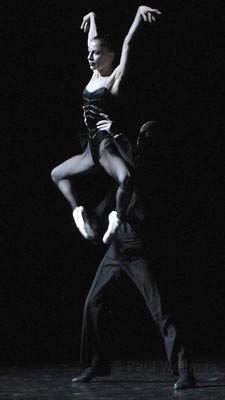Amjad, presented by La La La Human Steps.
At the Granada Theatre, Tuesday, April 8.

Amjad is an Arabic word that can mean both “man” and “woman,” an intentionally ambiguous title for this sprawling, postmodern ballet. In many ways, the identity of this work is obscured; what comes through the dim and shifting lights, abstract film projections, and severe, rapid dancing is as vague and as vivid as a dream.
Edouard Lock takes as his starting points Swan Lake and Sleeping Beauty, and familiar musical refrains rise to the surface before being swallowed by pulsing electronic tones and scratches. Heavy strips of textured, industrial metal frame the space, and three circular screens depict a shifting series of images: a tangle of roots, then a string of white orbs like a pearl necklace.
Then there are the dancers. At turns illuminated and plunged into darkness, they move with vicious precision. The women are tightly wound, sinewy, sleek; their male counterparts wear loose black suits and ooze through space. What light there is falls in dramatic shafts, and often blinks and stutters, mimicking the behavior of a human eye.
In Amjad, everything is manipulation, from the way the dancers manhandle one another’s bodies to the way the composers mold Tchaikovsky into unrecognizable forms. As in a dream, this world is at once identifiable-there is the pas de deux, the solo, the hint at inner turmoil-and utterly surreal. Gone are the colors, the characters, and the linear narrative. As in Matthew Bourne’s Swan Lake, these swans are aggressive creatures whose birdlike beauty has more to do with power than with delicacy. They flap their arms boldly, and cock their heads on long, muscular necks.
Although Lock’s dancers are exquisite and his concepts intriguing, Amjad lacks the kind of artistry that can make two hours seem like 20 minutes. By the time the screens descended for the third and final segment of film projections, the razzle-dazzle finale came as a relief. Yet the genius of Amjad is in its ability to evoke memories we may not have even known we had. Like it or not, the collective dream of classical ballet is forever altered.



